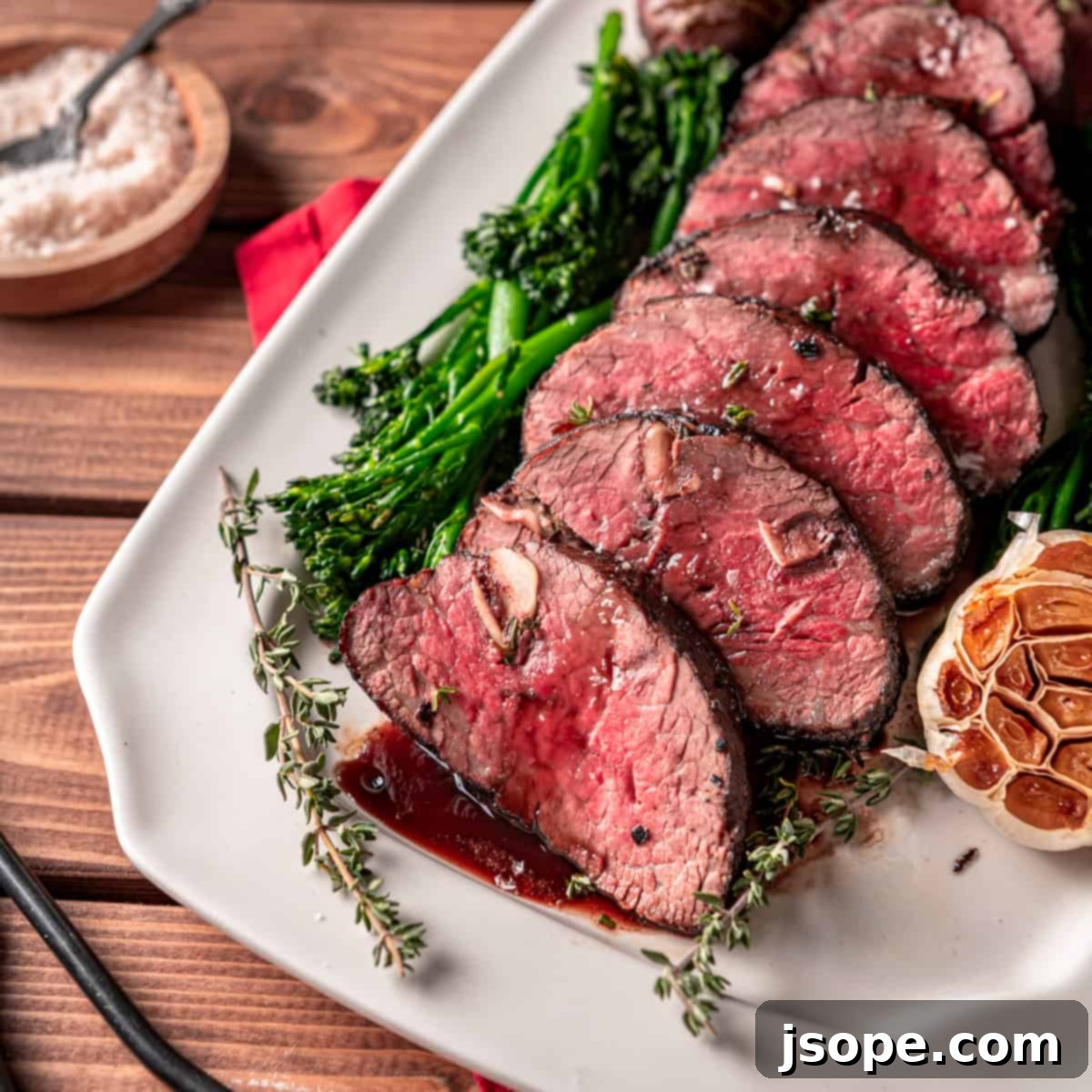The holiday season, with its festive cheer and special gatherings, presents the perfect opportunity to create a truly memorable meal. Imagine a magnificent, perfectly cooked beef tenderloin roast, adorned with aromatic garlic and thyme, and finished with a rich, luscious red wine sauce. This year, we are thrilled to share one of our most cherished recipes, ideal for Christmas Eve, Christmas dinner, or even a sophisticated New Year’s Day celebration. Our Garlic Thyme Studded Beef Tenderloin Roast with Red Wine Sauce is more than just a dish; it’s a showstopper, designed to impress your guests and elevate any special occasion.
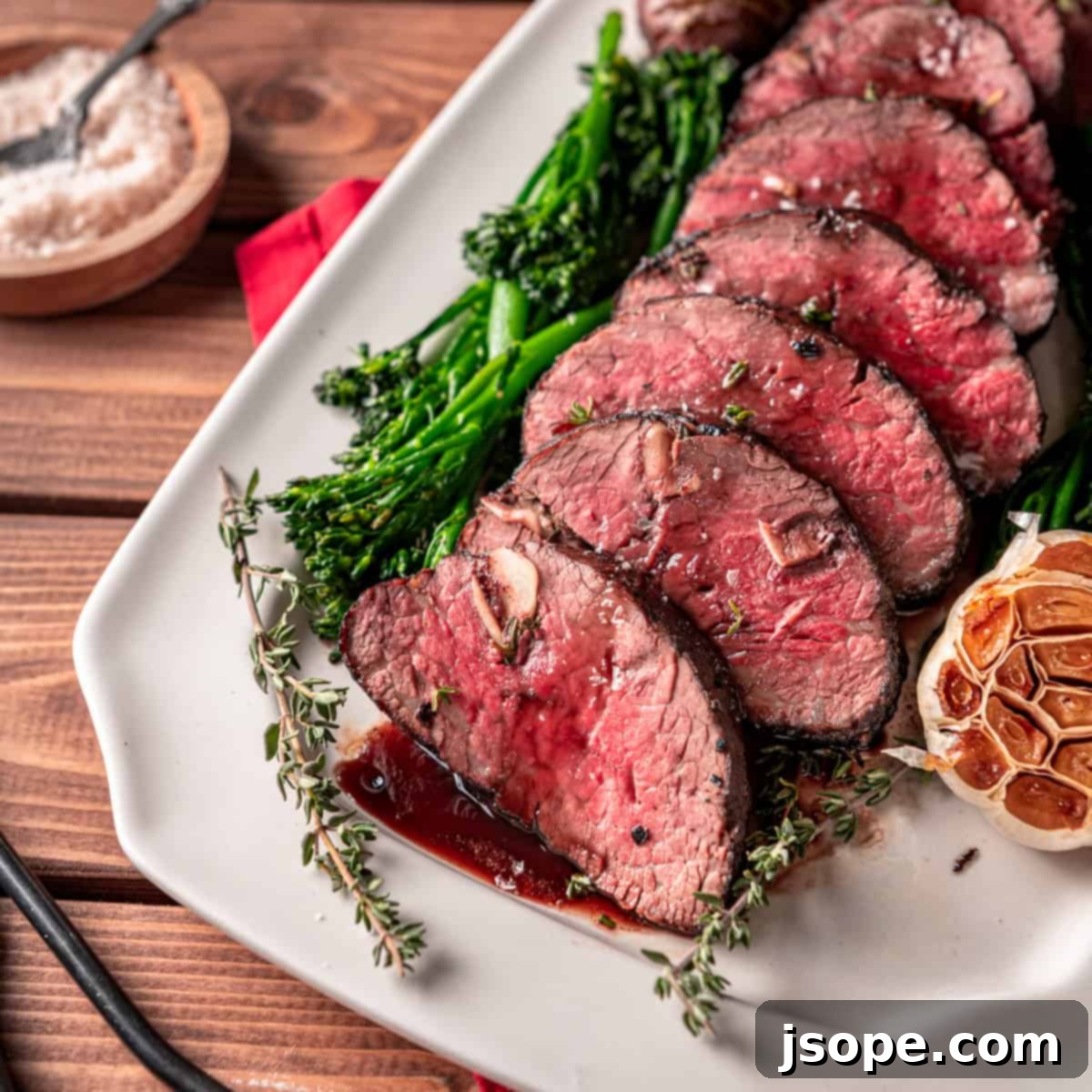
Few dishes command attention quite like a beautifully roasted beef tenderloin. It’s the quintessential centerpiece for feeding a crowd during the festive season or any significant event. This particular recipe, featuring a delicate yet intensely flavorful red wine sauce, promises a culinary experience you and your guests will rave about and want to recreate time and again. The rich, savory notes of the red wine sauce are meticulously crafted to complement the tender beef, enhancing its natural flavor without overpowering it.
If you’re exploring other tenderloin options, perhaps a succulent pork alternative, be sure to explore our recipe for Herb Crusted Pork Tenderloin with Juniper Red Wine Sauce.
Why Choose Beef Tenderloin for Special Occasions?
Beef tenderloin, often hailed as the king of roasts, is a prized cut for its unparalleled tenderness and delicate flavor. Its lean profile and fine texture make it a highly sought-after choice for celebratory meals. When cooked correctly, it yields a melt-in-your-mouth experience that is simply unforgettable. While it might be a splurge, especially during the holidays, its impressive presentation and exquisite taste make it well worth the investment. This recipe transforms a premium cut of meat into a masterpiece, ensuring every slice is a testament to culinary excellence.
Mastering the Roast: Low & Slow Cooking for Perfect Tenderloin
Achieving a perfectly cooked beef tenderloin, with an even temperature throughout, is an art form, and roasting is undoubtedly one of the best methods. Our preferred technique involves roasting the tenderloin at a low heat. This approach ensures that every guest receives a uniformly cooked, tender filet when sliced, rather than a roast that is overcooked on the outside and undercooked in the center. Here’s why this “low and slow” method at 300°F is superior:
- Gradual Temperature Rise: By maintaining a relatively low oven temperature of 300°F, the meat gradually comes up to temperature. This gentle cooking prevents the outer layers from drying out or overcooking, a common pitfall with higher temperatures where you risk a tough exterior and a raw interior. The goal is a consistent doneness from edge to edge, ensuring every bite is succulent and flavorful.
- Controlled Carryover Cooking: Carryover cooking refers to the process where meat continues to cook after being removed from the oven due to residual heat. At lower roasting temperatures (300°F), the carryover effect is less aggressive, typically around 7-10 degrees. This predictability allows for greater precision in achieving your desired doneness. You can remove the roast slightly before its target internal temperature, knowing that it will continue to cook perfectly as it rests. This control is crucial for tenderloin, where even a few degrees can make a significant difference.
To enhance the texture and flavor, we incorporate a final searing step *after* the roast comes out of the oven. This quick sear in a super hot skillet creates a beautiful, caramelized crust on the outside, adding another layer of flavor and visual appeal. This searing should be swift, no more than a minute per side, to avoid overcooking the tender, internal meat.
The Art of “Studding”: Infusing Flavor Deep Within
The term “studded” refers to a technique where we artfully insert slices of garlic and sprigs of fresh thyme directly into the raw beef tenderloin. This is achieved by making small, strategic slits across the surface of the meat and carefully pushing the aromatic ingredients into these openings. This method is not just for aesthetics; it’s a powerful way to infuse profound flavor throughout the roast.
When the tenderloin is sliced, the embedded garlic and thyme create a visually stunning presentation. However, it’s essential to pre-sauté the garlic before studding. Given that beef tenderloin cooks relatively quickly and at a lower temperature, raw garlic might not fully cook through, resulting in an unpleasantly pungent and raw taste. A brief sauté softens the garlic, sweetens its flavor, and ensures it melts into the meat, adding a wonderfully mellow and savory depth to every bite. This simple extra step makes all the difference, transforming the flavor profile of the entire dish.
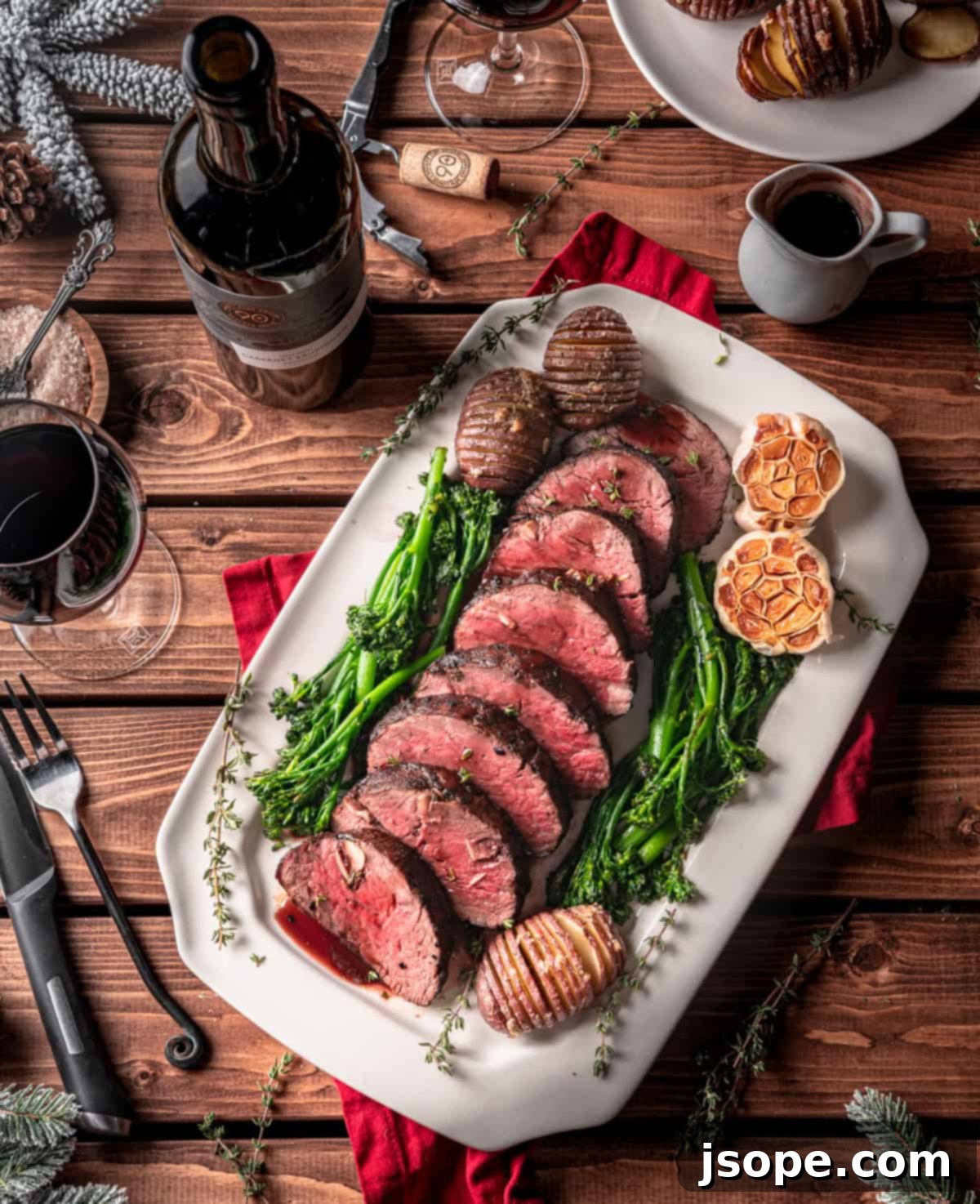
Essential Ingredients for Your Perfect Roast
Creating this exquisite beef tenderloin begins with selecting high-quality ingredients, most of which are readily available at your local grocery store. Each component plays a crucial role in building the dish’s complex flavors.
- Beef Tenderloin: For this recipe, we recommend a beef tenderloin weighing approximately 2-4 lbs, depending on your guest count. When sourcing, aim for USDA Prime beef over USDA Choice or Select. Prime beef boasts superior marbling and flavor, offering an unparalleled dining experience. If Prime isn’t available, USDA Choice is a good alternative, but we advise against Select for this special occasion dish due to its lower quality. Given that beef tenderloin is already a premium cut, choosing a higher grade is a worthwhile indulgence for a holiday feast.
- Fresh Garlic Cloves: Essential for both studding the beef and sautéing for the compound butter. Always opt for fresh garlic for the best aromatic intensity.
- Unsalted Butter: Used generously throughout the recipe, from sautéing garlic to creating the compound butter and finishing the sauce, unsalted butter allows you to control the overall seasoning.
- Thyme Sprigs: Fresh thyme is key for studding the beef. We use the tender tips of the sprigs, ensuring their delicate flavor permeates the meat.
- Thyme Leaves: Separately, chopped thyme leaves are incorporated into the compound butter, adding an earthy, herbaceous note to the exterior of the roast.
- Shallot: This elegant member of the onion family provides a milder, sweeter, and more nuanced flavor than a regular onion, used in both the compound butter and the red wine sauce.
- Salt and Black Pepper: Simple yet vital seasonings to enhance the natural flavors of the beef. We recommend kosher salt for its texture and even seasoning.
- Clarified Butter or Ghee: Perfect for searing the tenderloin. By removing milk solids, clarified butter or ghee allows for high-heat searing without burning, imparting a rich, buttery flavor and a beautiful crust. Olive oil or avocado oil can be used as alternatives.
Crafting the Luscious Red Wine Sauce: A Bordelaise Inspiration
The rich red wine sauce is truly the crowning glory of this dish, transforming the tenderloin into a gourmet experience. Inspired by classic Bordelaise, it’s a deep, savory reduction that perfectly complements the beef.
- Beef Stock: A high-quality beef stock, preferably low-sodium or sodium-free, forms the flavorful foundation of the sauce, providing a concentrated beefy essence.
- Unsalted Butter: Used in stages for sautéing shallots and whisked in at the end to create a velvety, emulsified finish.
- Shallot: Finely diced shallots are gently sautéed to release their sweet aromatics, contributing depth to the sauce.
- Dry Red Wine: The soul of the sauce! Always choose a dry red wine you genuinely enjoy drinking. While it doesn’t need to be expensive, quality matters. Full-bodied varietals like Cabernet Sauvignon, Merlot, or Zinfandel work wonderfully, lending robust fruit and tannic structure to the reduction.
- Whole Black Peppercorns: These are added whole during the reduction to slowly infuse their pungent, spicy notes into the wine, which are later strained out for a smooth sauce.
- Bay Leaf: A single bay leaf adds a subtle, herbaceous backbone to the sauce as it simmers.
- Red Wine Vinegar: A touch of red wine vinegar at the end brightens the sauce, adding a crucial acidic counterpoint that balances the richness.
Refer to the recipe card for precise quantities to ensure a perfectly balanced and delectable sauce.
Smart Substitutions for Every Cook
While we recommend the specified ingredients for optimal flavor, we understand that flexibility in the kitchen is key. Here are some reliable substitutions:
- Clarified Butter or Ghee Alternatives: If you don’t have clarified butter or ghee for searing, high smoke point oils such as olive oil or avocado oil make excellent substitutes, ensuring a crisp crust without burning.
- Shallot Substitute: A sweet yellow onion, finely diced, can be used in place of shallots for a similar aromatic base, though the flavor will be slightly more robust.
- Beef Stock Alternatives: While beef stock is ideal for enhancing the sauce’s beefy richness, a full-flavored vegetable stock or even chicken stock can be used in a pinch. Consider roasting the vegetables for vegetable stock to deepen its flavor.
- Red Wine Vinegar Alternatives: Other wine vinegars, such as white wine vinegar or sherry vinegar, can successfully replace red wine vinegar, offering a comparable tangy complexity to the sauce.
Recommended Equipment for Success
You likely already possess most of the tools needed for this recipe. However, a few specific items will significantly streamline the process and ensure a perfect outcome:
- A roasting pan with a wire rack is essential for even cooking and proper air circulation around the tenderloin.
- Kitchen twine (also known as butcher’s twine) is necessary for tying the tenderloin, helping it maintain a uniform shape during roasting.
- A good saucepan or high-sided medium frying pan is needed for preparing the exquisite red wine sauce.
- Above all, we highly recommend a reliable meat thermometer. This is your best friend for ensuring the beef tenderloin reaches your desired level of doneness without overcooking. Modern wireless thermometers, like the Meater Plus, offer the convenience of tracking internal temperature from your phone, making the cooking process virtually foolproof.
Step-by-Step Cooking Instructions
While this recipe requires some planning, each step is straightforward, leading to an incredibly rewarding meal. Let’s break it down.
Step 1: Prepare Your Beef Tenderloin
Start by thoroughly drying the entire beef tenderloin with paper towels. Trim any excess fat and the silver skin, which can become tough when cooked. Then, tie the tenderloin in 3-4 places with kitchen twine. This crucial step helps the roast maintain its uniform cylindrical shape, ensuring even cooking. For optimum results, proceed to the “Stud the Beef” step, then consider the optional aging process.
Step 2: Stud the Beef with Garlic and Thyme
Begin by thinly slicing your peeled garlic cloves. In a small pan, melt 3 tablespoons of unsalted butter over medium heat. Add the sliced garlic and sauté for just 1-2 minutes until softened and fragrant, ensuring it doesn’t brown. This removes the raw, bitter edge and sweetens the garlic. Remove the garlic from the butter and set aside (you can save the garlic butter for other uses!).
Next, using a sharp, thin knife, make small, deep slits all over the raw tenderloin. Gently insert a slice of the sautéed garlic and a thyme tip into each slit, pushing them deep into the meat with your finger if necessary. Distribute the garlic and thyme evenly across the top, bottom, and sides of the tenderloin.
Optional Aging Step: For enhanced flavor and texture, place the studded beef tenderloin, uncovered, on a wire rack set over a baking tray in the refrigerator for at least 2 hours, or up to two days. This dry-aging process allows the surface to dry out slightly, concentrating the beef’s flavor and promoting a better crust during searing. (See “Pro Tip: Aging Your Beef Tenderloin” below for more details.) If time is short, you can proceed directly to the next step after coating the beef with compound butter.
Step 3: Roasting the Beef
About 30 minutes before you plan to cook, remove the beef tenderloin from the refrigerator to allow it to come closer to room temperature. While it rests, preheat your oven to 300°F. In a small bowl, combine 8 tablespoons of softened unsalted butter with the chopped thyme leaves and finely diced shallot to create a fragrant compound butter. Season the beef tenderloin generously with kosher salt and black pepper, then rub the compound butter evenly over the entire surface of the roast.
Place the butter-coated beef tenderloin on a rack in a roasting pan. Roast in the preheated oven on the center rack for approximately 45-60 minutes, or until an instant-read thermometer inserted into the thickest part reads 125°F. This temperature is ideal for a medium-rare finish, accounting for the 7-10°F of carryover cooking that will occur while the meat rests. Cooking times may vary based on your oven’s calibration and the initial temperature and size of your roast, so begin checking the temperature after 40 minutes and monitor closely. While the beef roasts, begin preparing your red wine sauce.
Achieving Your Desired Beef Doneness
The perfect doneness is a matter of personal preference. Use your meat thermometer as your guide, remembering to account for carryover cooking after the roast leaves the oven. Here’s a quick guide:
- Rare: 120-130°F (Remove from oven at 110-120°F)
- Medium Rare: 130-135°F (Remove from oven at 120-125°F)
- Medium: 135-145°F (Remove from oven at 125-135°F)
- For Medium Well and beyond… we encourage you to reconsider for tenderloin to truly appreciate its delicate texture!
Hint: Always remove your roast from the oven BEFORE it reaches the final desired temperature, anticipating approximately 10°F of carryover cooking.
Step 4: Make the Sauce
While your beef tenderloin is roasting, prepare the luxurious red wine sauce. Start by adding 2 cups of beef stock to a medium saucepan over medium heat. Reduce the stock until approximately ⅔ cup remains. This step concentrates the beefy flavor. Once reduced, remove from heat and set aside.
In the same saucepan, add 1 tablespoon of unsalted butter and melt over medium heat. Add the finely diced shallots and sauté for a few minutes until they are tender and just begin to brown, releasing their sweet aroma. Next, pour in 1 cup of dry red wine, add the whole black peppercorns and bay leaf. Continue to cook, stirring occasionally, until the wine reduces significantly, leaving about ¼ cup of liquid in the pan. The alcohol will cook off, leaving behind a rich, concentrated wine flavor.
Carefully strain the sauce through a fine-mesh sieve to remove and discard the solids (shallots, peppercorns, bay leaf). Return the smooth liquid to the saucepan. Add the red wine vinegar and the previously reduced beef stock. Continue to cook over low heat, stirring, until the sauce thickens slightly and coats the back of a spoon. Reduce the heat to low to keep warm until your roast is ready, ensuring it doesn’t boil.
Step 5: Sear the Beef
Once the beef tenderloin reaches 125°F internally, remove it from the oven. For that irresistible crust, heat a large, heavy-bottomed skillet (a cast-iron skillet is ideal) over high heat until it is smoking hot. Add 2 tablespoons of clarified butter or ghee to the hot pan and allow it to melt. Carefully place the roasted tenderloin in the skillet and sear on all sides, turning every 30-60 seconds, for a maximum of 1 minute per side. The goal is a quick, deep caramelization, not further cooking of the interior. Remove the seared tenderloin to a clean cutting board and let it rest for 8-10 minutes. This resting period is crucial for the juices to redistribute, ensuring a tender, moist roast.
Step 6: Finish the Sauce, Slice the Beef, and Serve
While the tenderloin rests, remove the red wine sauce from the heat. Whisk in the remaining 2 tablespoons of unsalted butter (or more, to taste). This “montage au beurre” technique adds richness, gloss, and a silken texture to the sauce. Taste for seasoning and adjust with salt as needed. Your magnificent sauce is now ready to serve. If necessary, you can gently reheat the sauce over very low heat just before serving, but be careful not to bring it to a boil or heat it too quickly, as this could cause the emulsion to break. Slice the rested beef tenderloin into individual portions, generously spoon the luscious red wine sauce over each slice, and serve immediately.
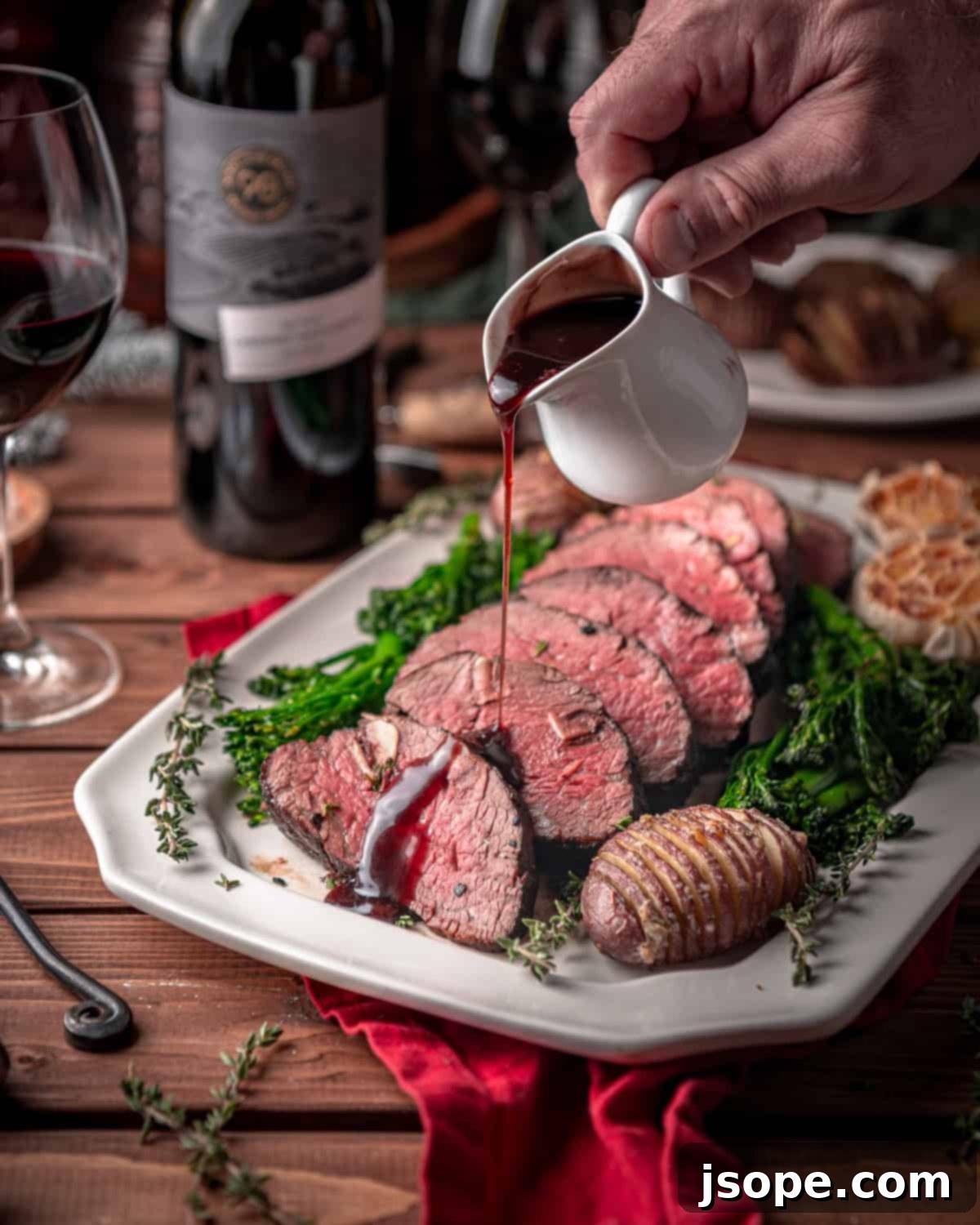
Variations to Customize Your Roast
While our signature Garlic Thyme Studded Beef Tenderloin is a perennial favorite, there are many ways to adapt this recipe to your personal preferences and explore new flavor profiles:
- Add Different Herbs: Thyme is a classic pairing for beef tenderloin, but don’t hesitate to experiment! Rosemary or sage can be substituted for thyme, or used in combination, to lend different aromatic notes. Consider a blend of fresh herbs for a more complex profile.
- Explore Different Sauces: The world of sauces is vast and exciting! Beyond our red wine sauce, you could try:
- Our Juniper Red Wine Sauce for a uniquely botanical twist.
- A rich Zinfandel Red Wine Reduction for a bolder, fruitier accompaniment.
- A surprising Blueberry Thyme Red Wine Reduction for an intriguing sweet and savory balance.
- For a truly unique and luxurious alternative, our Brandy Peppercorn Cream Sauce offers a creamy, spicy contrast that is incredibly satisfying.
Don’t Skip the Red Wine Sauce!
As enthusiasts of fine steak, we often advocate for enjoying high-quality beef unadorned, allowing its natural flavors to shine. However, with this particular recipe, we implore you: DO NOT SKIP THE SAUCE!
This exquisite red wine sauce, subtly inspired by the classic Bordelaise, is designed not to mask but to magnify the inherent richness of the beef tenderloin. It’s a symphony of flavors that harmonizes perfectly, creating an elevated dining experience. The sauce is so wonderfully complex and addictive that, honestly, licking the plate clean is not only appropriate but highly encouraged! Its layers of savory, slightly tangy, and deeply aromatic notes transform the tenderloin into a restaurant-quality dish that will undoubtedly ‘wow’ your guests and leave a lasting impression.
Why Coat Your Tenderloin with Compound Butter?
You might wonder about the purpose of coating your tenderloin with compound butter, especially since a good portion of it melts off during roasting. While it’s true some butter will drip away, the benefits it imparts are immense and undeniable.
Firstly, the compound butter acts as a basting agent, continuously moisturizing the surface of the roast as it cooks. This helps to keep the beef incredibly juicy and prevents it from drying out, even with its lean profile. Secondly, the infused herbs and shallots in the butter directly flavor the exterior of the tenderloin, creating a delicious crust and an aromatic depth that permeates the entire roast. We’ve conducted taste tests with and without compound butter, and the difference in overall taste and texture is significantly noticeable—the butter-coated roasts consistently emerge as the preferred choice.
Furthermore, the small holes created when studding the beef with garlic and thyme provide perfect pockets for the melting butter to seep into. This internal basting further enhances the juiciness and flavor penetration, making every single slice of your tenderloin even more succulent and irresistible.
Storage and Reheating Tips
This Garlic Thyme Studded Beef Tenderloin Roast is undoubtedly best enjoyed fresh, directly after roasting and resting. However, should you be fortunate enough to have leftovers, here’s how to properly store and reheat them to maintain quality:
How to store leftovers in the fridge:
Allow the beef tenderloin to cool completely before transferring it to an airtight container. Store the roast and the red wine sauce in separate airtight containers in the refrigerator for up to 5 days. We do not recommend freezing beef tenderloin leftovers, as it can significantly alter the texture upon thawing and reheating.
How to reheat leftovers:
To gently reheat the beef tenderloin, remove it from the refrigerator and allow it to come to room temperature for about 15-20 minutes. Wrap the beef tightly in aluminum foil and place it in a preheated 350°F (175°C) oven. Reheat until just warmed through, typically 15-20 minutes, depending on the thickness. Avoid over-reheating, which can dry out the meat. Reheat the sauce gently in a saucepan over low heat, stirring occasionally, ensuring it doesn’t come to a boil.
Pro Tip: Aging Your Beef Tenderloin Prior to Roasting
For a truly professional touch and an unparalleled depth of flavor, consider dry-aging your beef tenderloin for a period before roasting. This simple, yet transformative technique involves placing the prepared (studded) roast on a wire rack, uncovered, in the refrigerator for several hours, or ideally, up to two full days. While it sounds unconventional, this process:
- Enhances Flavor: As the surface of the beef dries out, its natural flavors become more concentrated and intense, leading to a richer tasting roast.
- Improves Texture: The drying process creates a firmer surface, which is ideal for achieving a superior crust during the final searing step.
You will undoubtedly notice a remarkable improvement in both texture and flavor, making you a convert to this easy technique. You can perform all the initial prep work (trimming, tying, studding) in the morning for an evening dinner, allowing sufficient time for the flavors to develop. However, for the most profound results, we highly recommend prepping the beef the night before and letting it dry overnight and throughout the following day. If you have the time and can plan ahead, this dry-aging step is a game-changer for your holiday beef tenderloin!
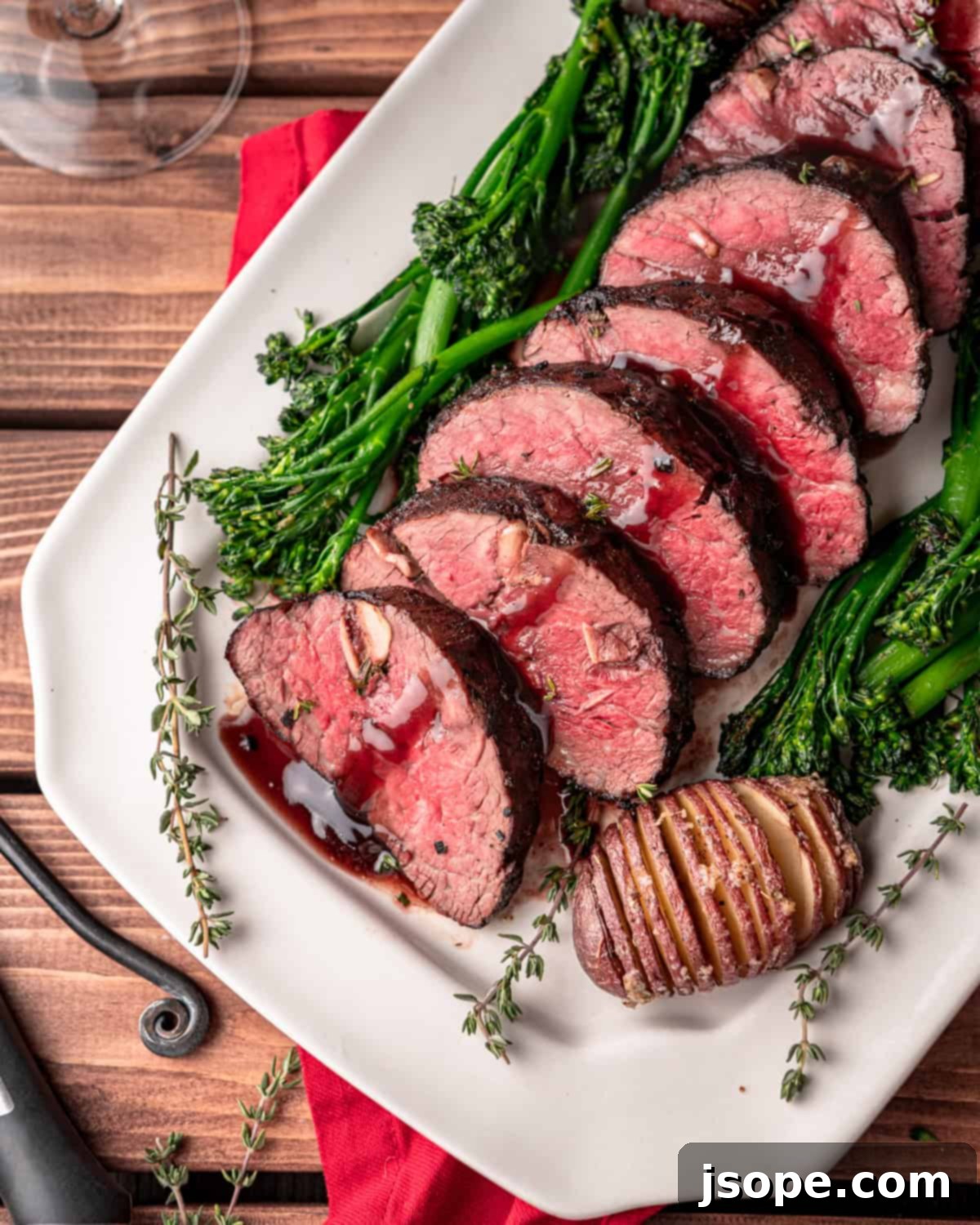
What to Serve with Beef Tenderloin: Perfect Pairings
A grand main course like Garlic Thyme Studded Beef Tenderloin deserves equally impressive side dishes. Here are some of our favorite pairings that will complete your festive meal:
- For a visually stunning and delicious potato side, serve it with our Hasselback Red Potatoes with Chive Butter.
- To complement the garlic notes in the roast, rich and creamy Roasted Garlic Blue Cheese Tarragon Mashed Potatoes are an exquisite choice.
- For a lighter, yet equally flavorful accompaniment, consider a crisp Grilled Romaine and Pear Steakhouse Salad or a wholesome Sheet Pan Chickpea and Vegetable Medley Dinner.
- If you’re leaning towards an Italian-inspired spread, our creamy (but no cream!) Fettuccine Alfredo with Mushrooms or a savory Smoked Gouda and Porcini Mushroom Polenta would pair beautifully.
- Don’t forget a vibrant green vegetable like broccolini or asparagus, simply roasted with olive oil and a sprinkle of salt and pepper, to add color and freshness to the plate.
Beef Tenderloin Roast Wine Pairings
No holiday feast, especially one featuring such a magnificent beef tenderloin, is complete without the perfect wine pairing. The richness of the beef and the savory depth of the red wine sauce call for a bold and flavorful companion.
Our top recommendation is a full-bodied Cabernet Sauvignon. Its robust structure, firm tannins, and notes of blackcurrant, cedar, and sometimes a hint of mint, beautifully cut through the richness of the beef and harmonize with the red wine sauce. It’s a truly classic pairing that is also delightful to savor on its own.
Other exceptional full-bodied red wines that complement this dish include:
- Bordeaux: A classic French blend, often Cabernet Sauvignon and Merlot dominant, offering elegance and complexity.
- A fine French Burgundy or a similar style of Pinot Noir from a well-regarded region (e.g., Oregon, California) can also be an excellent choice. While typically lighter-bodied, a well-structured Pinot Noir with earthy notes and bright acidity can provide a lovely contrast and enhancement.
- From Italy, powerful red wines like Brunello di Montalcino (Sangiovese-based) or Barolo (Nebbiolo-based) offer profound complexity, firm tannins, and deep fruit characteristics that stand up beautifully to the tenderloin and its sauce.
Choose a wine that you enjoy drinking, and it will undoubtedly elevate your dining experience to new heights.
Frequently Asked Questions About Beef Tenderloin Roast
Roasting your beef tenderloin in the oven at a low temperature, specifically 300°F for about 45-60 minutes, is considered the easiest and most effective way to cook this holiday roast. This method consistently yields a delicious, juicy, and uniformly cooked beef tenderloin.
Yes, it is highly recommended to trim excess fat and remove the tough silver skin from the beef tenderloin before roasting. You can also trim off the smaller, thinner tail end of the tenderloin. This tail end can be saved for other dishes, such as beef stew, braised beef ragu, or even sliced thinly for an appetizer like steak crostini.
Roasting at a low temperature is our preferred and recommended method. Cooking a tenderloin at a lower temperature for a slightly longer duration ensures a more uniform doneness throughout the entire roast, preventing an overcooked exterior and an undercooked center.
No, beef tenderloin and prime rib are distinct cuts of meat from different parts of the cow. Beef tenderloin yields filet mignon steaks, known for their leanness and tenderness. Prime rib (or rib roast) yields ribeye steaks and is typically much larger, with significant marbling and fat, offering a richer, more robust flavor. Both are excellent roasts but differ greatly in characteristics.
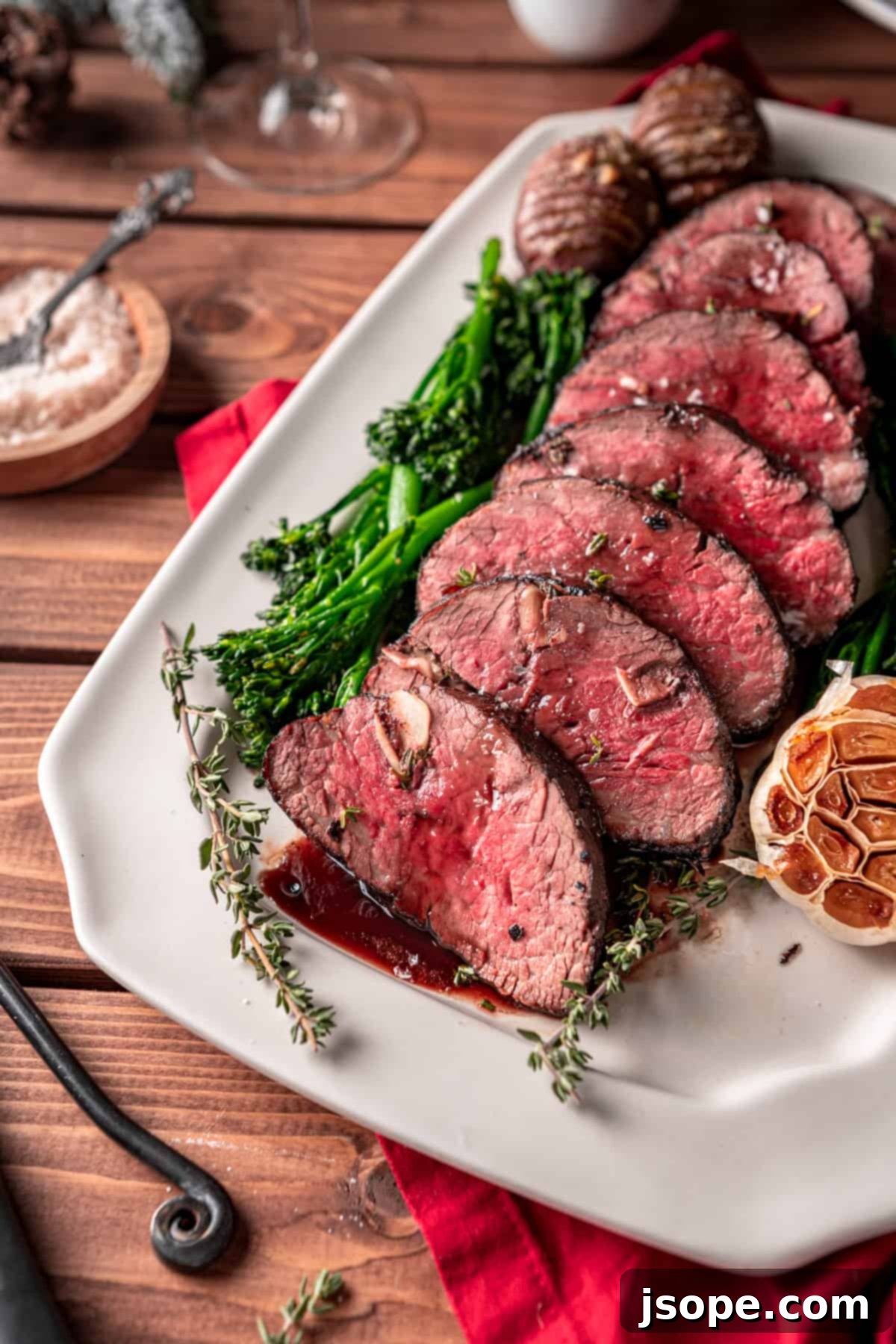
Enjoy!
We sincerely hope this detailed guide helps you create an unforgettable holiday feast with our Garlic Thyme Studded Beef Tenderloin Roast with Red Wine Sauce. This dish is designed to bring joy and gourmet flavor to your special occasions.
If you try this magnificent recipe, please leave us a comment below and share your experience! We’d love to see your creations, so don’t forget to tag us on Instagram @cooking_with_wine!
Looking for more inspiring recipes to impress your guests? Explore some of our other popular main courses below:
- Sage Prosciutto and Gruyere Chicken Roulade
- Caffè Mocha Lamb Lollipops
- Coq au Vin – Chicken in Red Wine
- Spinach and Sun Dried Tomato Pesto Stuffed Pork Tenderloin
- Peppercorn Crusted Steak with Brandy Cream Sauce
Related Recipes for Your Holiday Table
Still searching for other exceptional meat recipes for the holidays or special dinners? Here are more delectable options to consider:
- Marinated Lamb Chops with Mint and Cilantro Yogurt Sauce
- Dry-Rubbed Roasted Pork Tenderloin Recipe
- Grilled Marinated Tri Tip Steak – Ultimate Marinade Recipe
- Crispy Sous Vide Pork Belly Bites with Ginger Soy Glaze
Festive Cocktails to Complement Your Meal
Beyond wine, elevate your holiday celebration with some of our favorite festive cocktails, perfect for pairing with this meal or enjoying throughout the season:
- Spiced Cranberry Old Fashioned Cocktail Recipe
- Shimmy Shimmy Coconut Basil Lime Gin Cocktail
- Spiced Apple Cider Moscow Mule Cocktail Recipe
- Fig Cardamom Gin Old Fashioned Cocktail
📖 Recipe: Garlic Thyme Studded Beef Tenderloin Roast with Red Wine Sauce
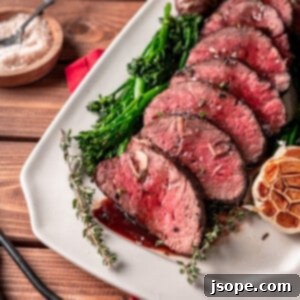
Garlic Thyme Studded Beef Tenderloin Roast with Red Wine Sauce
★★★★★ 5 from 3 votes
Pin Recipe
30 mins
1 hr
10 mins
1 hr 40 mins
Main
American
6 servings
704 kcal
Equipment
- 1 roasting pan and rack
- kitchen twine/butchers’ twine
- 1 medium saucepan
- 1 meat thermometer
- 1 castiron skillet
Ingredients
For the Beef
- 1 Beef Tenderloin Roast (about 2-3 lbs)
- 4 garlic cloves
- 3 tablespoon unsalted butter
- 12 thyme tips (just the tender end of the stalk, intact)
- 1 small shallot (15-20g), finely diced
- 2 sprigs thyme – leaves only, chopped
- 8 tablespoon unsalted butter – softened
- 1 tablespoon kosher salt
- 1 teaspoon black pepper
- 2 tablespoon clarified butter (or ghee) for searing
For the Sauce
- 2 cups beef stock
- 4 tablespoon unsalted butter, divide
- 1 medium shallot (30g), finely diced
- 1 cup dry red wine
- 3 peppercorns
- 1 small bay leaf
- ½ teaspoon red wine vinegar
- 2 tablespoon unsalted butter
Instructions
Prepare the Beef
- Completely pat dry your beef tenderloin. Tie it with butchers’ twine in 3-5 places to ensure the roast stays uniform. Set aside.
- Prepare your garlic by thinly slicing the peeled garlic cloves. Heat a small pan on medium heat and add the 3 tablespoon of butter. Once the butter has melted, add the thin slices of garlic and sauté for just a minute or two. The garlic should not brown (a little around the edges is OK) but should cook enough that it sweetens up and loses the bitterness of raw garlic. Remove the garlic and discard the butter or save for another use (garlic butter!).
- Using a thin, sharp knife, make holes in the tenderloin roast. Slide the garlic and/or thyme tips down the knife and, if needed, use your finger to push the garlic/thyme deep into the cut. Do this in various places of the tenderloin (top, bottom, and sides). Most or all holes can have both garlic and thyme, but some can just have one or the other if you wish.
- Optional: We recommend (see note) that you place the meat on a rack over a sheet-tray, uncovered, in the refrigerator for several hours before roasting or up to 2 days to air dry and age. When ready to cook, remove the beef from the refrigerator and let it sit at room temperature for at least 30 minutes.
Roast the Beef Tenderloin
- Preheat your oven to 300°F
- Next, mix the softened butter with the chopped thyme leaves and shallot to make a compound butter. Season the roast with the salt and pepper. Smear the butter all over the tenderloin roast and then put it on a roasting rack over a sheet pan or roasting pan.
- Put the roast in the oven and cook until an instant-read thermometer reads 125°F for medium rare (the carryover will be about 7-10°F while the beef rests after searing). This will take about 45 minutes, but after 40 minutes, you should start taking the temperature of the beef. Depending on your oven and how cold the meat was in the center when it went in, it could take up to 60 minutes. Temp it often so that you don’t overcook your beef.
Make the Sauce
- While your beef tenderloin is roasting, add the beef stock in a saucepan over medium heat and reduce until you have ⅔ of a cup. This can be done ahead of time. Set aside.
- To a saucepan, add 1 tablespoon butter over medium heat. Add the shallot and cook, stirring, until the shallot is tender and just starts to brown. Add the wine, peppercorns, and bay leaf. Stir, and cook until there is only about ¼ cup of wine remaining.
- Next, strain out the solids and put the liquid back into the pan. Add the vinegar and your reduced beef stock. Stir and cook until thickened. Taste for seasoning – you’ll probably need a little kosher salt here. Remove from the heat and stir in the remaining 3 tablespoon butter (you can use more if desired). Keep warm until ready to serve but do not boil after the butter is added or your sauce will break.
Sear the Beef
- When the meat is at 125° in the center, remove it from the oven. Heat a heavy pan (cast iron works best) on high heat. Add the clarified butter and sear your roast on all sides, about a minute per side MAX. Place the meat on your cutting board and allow it to rest for about 8-10 minutes while you finish the sauce
Finish the Sauce, Slice the Beef and Serve
- Once your tenderloin has cooked and is resting, remove the sauce from the heat and whisk in the butter. Taste for seasoning and add salt to taste as needed. Your sauce is now ready to serve. You can gently reheat it over low heat right before serving with the tenderloin if necessary, but avoid bringing the sauce to a boil or heating too quickly or the sauce could break.
- Slice your beef tenderloin into individual portions and serve with the sauce.
Notes
Nutrition
Calories: 704kcal
Carbohydrates: 5g
Protein: 30g
Fat: 60g
Saturated Fat: 30g
Polyunsaturated Fat: 2g
Monounsaturated Fat: 21g
Trans Fat: 1g
Cholesterol: 176mg
Sodium: 1400mg
Potassium: 666mg
Fiber: 1g
Sugar: 1g
Vitamin A: 891IU
Vitamin C: 4mg
Calcium: 40mg
Iron: 4mg
beef, beef tenderloin, holiday meals, roasts
Tried this recipe?
Let us know how it was!
Food Safety Guidelines
Ensuring food safety is paramount when cooking, especially with meat. Please observe these essential guidelines:
- Always avoid using the same utensils on cooked food that previously touched raw meat without thorough cleaning.
- Wash your hands meticulously after handling raw meat.
- Do not leave perishable food sitting out at room temperature for extended periods.
- Never leave cooking food unattended; always supervise it.
- Use cooking oils with a high smoking point to prevent the formation of harmful compounds at high temperatures.
- Maintain good ventilation when using a gas stove to ensure proper air quality.
For more comprehensive food safety information, consult the USDA.gov guidelines.
